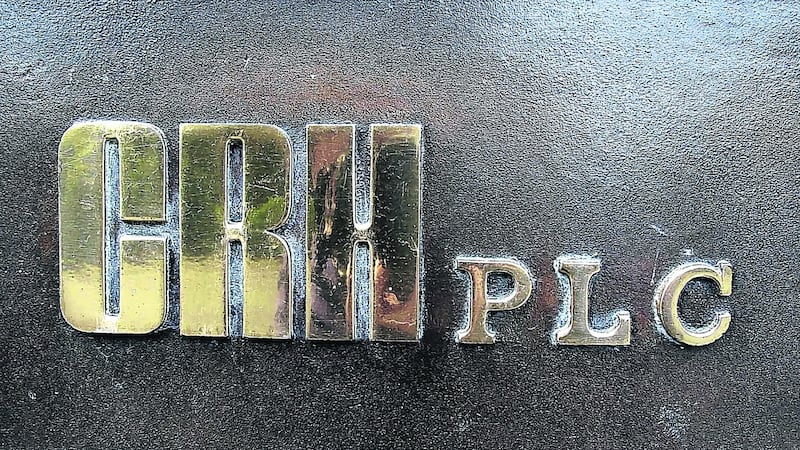CRH chief executive Albert Manifold, recovering from an orthopaedic procedure earlier in the week, was watching online from Ireland on Friday as his top lieutenants stepped up to present the building materials giant's full-year results to analysts in London.
He wasn't the only viewer that chief financial officer Senan Murphy and the rest of the team were conscious of tuning in over the web.
Europe's biggest activist investor, Stockholm-based Cevian has been publicly stalking CRH for over a year, since its managing partner, Christer Gardell, told Reuters it had built up a stake of under 3 per cent and let it be known that he was "convinced that CRH's assets could become significantly more valuable".

Comments like that from activist types tend to strike terror in corporate boardrooms.
The Swedes issued another little reminder of how they could be a thorn in the side of CRH in June when Gardell spoke to his favourite news agency again, criticising the company for having “become too complex, both structurally and operationally, which hampers performance and traps value”.
While acknowledging that the largest group on Dublin’s Iseq index had been doing some “good” restructuring work, he said that “continued far-reaching structural and operational improvements are needed for the group’s assets to reach full potential”.
Evidence
If evidence were needed of how Cevian tends to get its way – even if it has to play the long game – look no further than German industrial conglomerate ThyssenKrupp, in which it started buying shares in 2013.
On Thursday, ThyssenKrupp, in which Cevian now holds an 18 per cent stake, agreed to sell its elevator-making business to a consortium including private equity firms Advent and Cinven for €17.2 million in one of Europe's biggest buyout deals.
It draws a line under a long campaign by the Swedish firm to break up the steel-to-automotive technology giant. The feat is all the more stunning, given that Cevian had faced opposition for much of the time from powerful workers' groups, politicians and 21 per cent shareholder, the Krupp Foundation, a philanthropic organisation set up in part as atonement for German industrialist Alfried Krupp's role in developing weapons for the Nazis using slave labour.
It’s difficult to assess the effect Cevian’s presence on CRH’s shareholder register has had on management, but it has almost certainly helped to concentrate minds.
The group’s latest results statement shows how CRH has worked hard at simplifying itself over the past 12 months, raising €2.1 billion from asset sales, including its European distribution unit and 50 per cent stake in an Indian cement business that was acquired just before the financial crash in 2008.
It spent €700 million on bolt-on acquisitions during the period, a tame amount by CRH standards.
But Manifold had already been running a ruthless show selling off underperforming or unwanted assets over the previous five years, raising €5 billion. The proceeds have been used to part-finance €13 billion of acquisitions of more attractive businesses – at cheaper valuations, relative to earnings – over the same period.
‘Active portfolio management’
"Active portfolio management is the new muscle we've developed in the past five years," David Dillon, group president of global strategy and business developments, told analysts on Friday.
The company is also reported to be looking to sell the Philippines cement business it inherited in a 2015 deal. The business, which seems to have turned a corner, having been loss-making for much of its time under CRH, may fetch more than $2 billion (€1.8 billion), Bloomberg reported last November.
In delivering 25 per cent growth in earnings before interest, tax, depreciation and amortisation (Ebitda), to €4.2 billion, CRH managed to turn an impressive 83 per cent of this into actual cash.
But the company already had an industry-leading cash conversion rate of 75-80 per cent over the six previous years.
Buyback plan
Meanwhile, CRH, which has spent €1.6 billion repurchasing its own stock in less than two years and is currently spending a further €200 million on buybacks, announced on Friday that it planned to step up its annual dividend by 15 per cent to 83 cent per share. The original buyback plan was announced months before Cevian raised its head.
The company also said it was changing the currency in which it reported earnings from euro to dollars, reflecting the fact that two-thirds of earnings were now generated in that currency. It was initially speculated, when Cevian acquired its stake, that it might press CRH to go a step further and seek a partial listing of its North American unit in New York to unlock value.
Although CRH expanded its Ebitda margin by an impressive 2.3 percentage points to 14.8 per cent last year, fuelled by deals, the underlying margin expanded by only half a point. That leaves some work to be done to meet its 2021 target of delivering a three percentage-point boost to underlying margins by 2021.
Still, Cevian had seen the value of its CRH stake rise by about 33 per cent in the 12 months since it revealed its cards in early February 2019 – compared to a 10 per cent advance by the wider MSCI Europe Materials Index.
That was before this week’s coronavirus-induced global equities slump knocked 11 per cent off the stock. For the moment, however, CRH has seen no impact from the spread of Covid-19, according to Murphy, as the group forecasts “a year of further progress” in 2020.
The stock market reaction this week suggests investors believe it’s only a matter of time.












